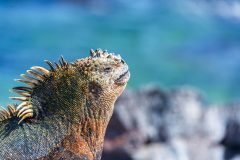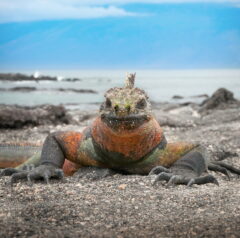Where to go when - our guide to Galapagos Islands
Discover the best time of year to visit the Galapagos Islands with our handy month by month guide.
December - February
The wet season in the Galapagos starts in December. During these months you can consistently expect clear blue skies, lots of sunshine and high temperatures (average highs of 26°C in December rising to 30°C in Feb). Snorkelers and divers will enjoy warm, calm waters and excellent visibility at this time of the year and the wet season rains are usually reserved to light afternoon showers in the highlands. With exceptional wildlife viewing all year, many consider these months an ideal time to escape the European winter and visit the archipelago. We therefore highly recommended booking well in advance, especially for Christmas holidays.
28°C Average max daytime temperature
18°C Average min nighttime temperature
11 days per season rainfall
Moderate humidity

March - May
This is the second half of the wet season so visitors at this time of the year will experience the same almost permanent sunny clear days and high temperatures of the preceding months. Rains are still mostly confined to the highlands, keeping them a lush green, and the calm warm seas and fantastic underwater visibility are ideal for those wishing to explore aboard a smaller expedition cruise or wanting to do lots of snorkelling. With great weather (assuming you’re not shy of the sometimes stiflingly hot days, which average 31°C by April!), it’s an equally popular time to visit as Dec-Feb so it’s advisable to book well ahead, especially for Easter week!
30°C Average max daytime temperature
18°C Average min nighttime temperature
8 days per season rainfall
Moderate humidity

June - August
The arrival of cold nutrient-rich ocean currents marks the start of the cooler dry season in June. Average highs drop to a more comfortable 24°C and you may need a light sweater in the evenings. Hazy skies offer some protection from the strong sun, which some people favour, and choppier seas make larger vessels a popular choice at this time of the year. Underwater visibility reduces but there’s a surge in underwater activity with larger shoals of fish and, in July and August, the chance to spot humpback whales and maybe even orcas and whale sharks. Being such a fantastic family holiday destination accommodation does book up early for the school holidays.
26°C Average max daytime temperature
16°C Average min nighttime temperature
11 days per season rainfall
Low humidity

September - November
The cooler dry season continues with more comfortable average highs of 24°C, choppier seas that favour larger vessels and colder nutrient rich waters with reduced visibility but incredible underwater activity. Hazy skies continue to protect from the strong sun and a low mist hangs in the highlands for much of the day. September and October are the best months for spotting humpback whales, orcas and whale sharks as well as large pods of dolphins and groups of rays and sharks. Water temperatures rise in November, winds ease and calmer seas mark the transition towards the warmer wet season to come.
25°C Average max daytime temperature
15°C Average min nighttime temperature
10 days per season rainfall
Low humidity

Papagaio
Your edit for Latin American inspiration
Our exciting range of articles on Latin America explore everything from iconic destinations and lesser-known cultural gems to delicious traditional recipes. You’ll also find exclusive travel tips, first-hand client reviews and the chance to get your personal questions answered by our travel experts.
View Extraordinary Inspiration







































